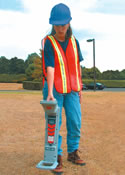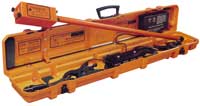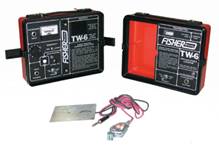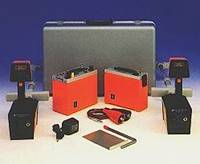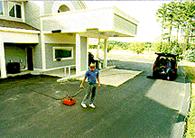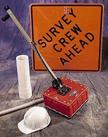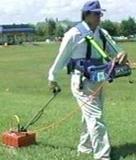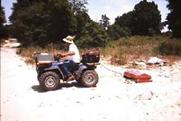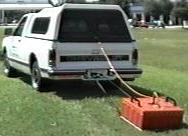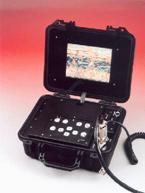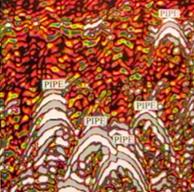| << Previous | Contents | Next >> |
Avoiding Utility Relocations
IV. Site Characterization and Utility Locating
Highway construction projects require a significant amount of planning and design before the actual construction work can begin. An important part of the planning and early design information gathered for a project includes subsurface site characterizations, such as various geologic and environmental studies. Just as important, however, is site characterization of subsurface utilities, which is often overlooked, or is not considered until actual construction begins. When utilities are finally considered, too much emphasis may be placed on old site diagrams or as-built diagrams that may not be reliable. For this reason, it is highly probable that undocumented or unknown utilities will be encountered when construction begins, resulting in possible project delays and cost overruns.
To avoid these delays, the planning and early design phases should include site characterizations of subsurface utilities. While not all utilities are detectable, utility-locating surveys will significantly reduce the uncertainty typically associated with these projects. Following is a discussion of the methodology of utility locating surveys, the recommended procedures that should be followed when planning and conducting a utility locating survey, and the limitations associated with utility locating surveys.
IV.1 Methodology
IV.1.1 Electromagnetic Line Location (EMLL)
Theory
EMLL techniques are used to locate the electromagnetic field resulting from alternating electric current (a.c.) flowing along a conducting metallic line. The magnetic field forms a cylindrical shape around the conductor and is called the “signal.” These signals can arise from currents that are naturally present in many conductors (known as passive signals) or currents applied to a line with a transmitter designed to produce an a.c. current of known frequency (known as active signals). The most common passive signals are generated by live 50-60-Hertz (Hz) power cables, power system return currents and long wave radio transmissions flowing along the convenient paths of lower resistance provided by metal pipes and cable sheaths. Active signals can be introduced by physically connecting a transmitter to the line at an accessible point and completing the circuit by a connection to ground. The conducted signal will usually then travel along the line and will be detectable over a distance dependent upon the type and size of the line, the type of joint, and the surrounding soil conditions. This is referred to as electromagnetic conduction (EMC). Alternatively, an active signal can be introduced onto a line through electromagnetic induction (EMI). This involves transmitting a high frequency a.c. current through the air to create a primary electromagnetic field in the space surrounding an underground line, which then induces a secondary magnetic field signal onto the line which is detectable by a receiver. Metallic pipes can be located using the induction mode by either placing the transmitter on the ground above or in close proximity to the utility, or by means of placing an induction clamp around the line. An induction clamp can only be used at accessible portions of the utility lines in vaults or breaker boxes. Nonmetallic pipes can be located using EMI by placing a Sonde inside of the pipe. The Sonde transmits a controlled frequency electromagnetic field that is then detected at the surface by a receiver above the transmitter.
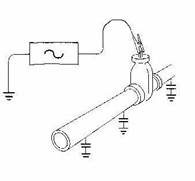 |
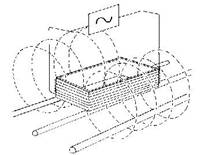 |
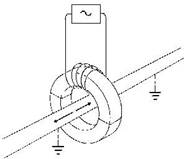 |
Active Signal |
Active Signal |
Active Signal |
|
(Source: www.radiodetection.com/theorybook) |
||
The detection of underground utilities is dependent upon the composition and construction of the line of interest. Utilities detectable with standard line location techniques include most continuously connected metal pipes, cables/wires or non-metallic utilities equipped with tracer wires. These generally include water, electric, natural gas, petroleum, telephone, cable TV, and other conduits related to facility operations. If there are no passive currents present, then these utilities must be exposed at the surface or in accessible utility vaults in order to have an active signal placed on them. Utilities that require additional EMLL techniques include those made of non-electrically conductive materials such as polyvinyl chloride (PVC), fiberglass, vitrified clay, and metal pipes with insulated connections. Generally, a steel fish tape or transmitting Sonde has to be placed into the pipe before these utilities can be detected.
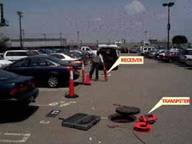 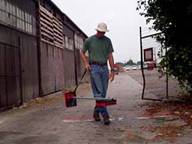
Metallic Pipe - Direct Connection and Surface Induction |
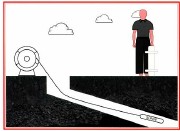
Non-Metallic Pipe – Sonde |
Buried objects can also be detected, without direct contact, by using the induction mode. This is used to detect buried metal utilities and near surface metal objects such as rebar, manhole covers, USTs, and various metallic debris. The induction mode is used by holding the transmitter-receiver unit above the ground and continuously scanning the surface. The unit utilizes two orthogonal coils that are separated by a specified distance. One of the coils transmits an electromagnetic signal (primary magnetic field) which in turn produces a secondary magnetic field about the subsurface metal object. Since the receiver coil is orthogonal to the transmitter coil, it is unaffected by the primary field. Therefore, the secondary magnetic fields produced by buried metal object will generate an audible response from the unit. The peak of this response indicates when the unit is directly over the metal object.
Equipment
The equipment used for EMLL surveys varies and is made by several different manufacturers. A few representative EMLL instruments are listed below:
- Radiodetection RD-400 and 500
- Metrotech 800 series pipe and cable locators
- Dynatel 2250 digital cable locator
- Fisher TW-6 inductive pipe and cable locator
- Schonstedt MAC 57 Bx pipe and cable locator
|
|
|
|
It should be noted that there are additional manufacturers and equipment that have not been mentioned. All of the instrumentation listed above specialize in the detection of utilities (pipes and cables) using both the EMC and EMI techniques. The Fisher TW-6 and Schonstedt MAC 57 Bx can also be used as a near surface ferrous metal detector.
IV.1.2 Ground Penetrating Radar (GPR)
Theory
GPR is a method that provides a continuous, high resolution cross-section depicting variations in the electrical properties of the shallow subsurface. The method is particularly sensitive to variations in electrical conductivity and electrical permittivity (the ability of a material to hold a charge when an electrical field is applied). The system operates by repeatedly radiating an electromagnetic pulse into the ground from a transducer (antenna). The antenna is hand drawn or towed by a vehicle as it is moved along a traverse. When the radar signal encounters an interface representing a change in permittivity (resulting in what is known as an impedance contrast) some of the electromagnetic energy is reflected back to the surface. Notably, when the signal encounters a metal object, virtually all of the incident energy is reflected. The reflected signals are received by the transducer and are printed in cross-section form (time-depth) on a graphical recorder. The resulting records can provide information regarding the location of underground metallic and non-metallic utilities, as well as backfill material that may indicate a utility trench. Generally speaking, electrically conductive materials such as clay soils can limit radar performance by reducing the depth of signal penetration.
|
|
Equipment
Both conventional and highway specific GPR systems are used to locate utilities. The most widely used conventional systems are the:
- Geophysical Survey Systems, Inc. (GSSI) SIR-2000,
- Sensors and Software pulseEKKO,
- Mala Geoscience RAMAC X3M.
These GPR systems comprise a computer processor and one or two antennae. Each system can be equipped with antennae that range from 100 to over 1,200 megahertz (MHz), depending on the objective of the survey and the desired depth of detection. The frequency range of 200 to 400 MHz is typically used for utility investigations. This frequency range generally provides high-resolution data within the depth range that utilities are buried (1 to 6 feet). The results are printed in cross-section form that shows a vertical 2-D slice (image) into the ground. The location of utilities can then be interpreted from these records in the field.
|
|
Recently, advanced GPR systems have been designed to evaluate the condition of new and existing transportation infrastructure, including both pavement and utility studies. Two of these are the HIGHWAY SCAN by GSSI, and the CART Imaging System by Witten Technologies, Inc. The HIGHWAY SCAN is best suited for rapid assessment of pavement layer thickness and structural evaluation. It can also be used to image near surface utilities. The CART Imaging System is a multi-channel GPR that provides a 3-D image of buried objects and utilities. Depending on soil conditions, the CART system can image the subsurface at depths greater than 10 feet. Both the HIGHWAY SCAN and CART system are designed to be towed behind a vehicle.
IV.2 Producers
A thorough set of procedures should be established to increase the probability that every detectable utility is located. These procedures should include reviewing all available utility maps and site conditions, inspecting the site for evidence of utilities, locating all detectable utilities, surveying the area for undocumented or unknown utilities, marking the detected location of the utilities on the ground, producing a site diagram, and documenting the findings in a written report.
IV.2.1 Pre-Planning
Utility Maps
Prior to starting a utility locating survey, an effort should be made to review all information possible related to utilities in the area. The search may provide beneficial information regarding the possible routing of specific utilities, including those that may not be evidenced by vault lids, valves, or above ground piping. Any information that can be reviewed prior to the utility locating survey can be used to increase success in locating all detectable utilities in a given area. Utility sources available for review include old project plans, as-built utility plans, and maintenance and repair records.
Project plans are created to show how a builder intends to develop a site. These plans may be helpful in determining what utilities may be in the area. It should be noted, however, that initial project plans may not be indicative of the final routing of utilities. In some cases, the routing of utilities are changed during construction. Final utility routing is usually shown on as-built utility plans. As-built maps are completed after a site has been developed and the utilities have been installed. These maps are important in determining the general location of a specific utility and where valve boxes, vaults, and above ground piping may be located. Maintenance and repair records indicate if new sections of pipe have been installed or if certain utilities have been abandoned in place or removed. In some cases, plastic or nonmetallic piping is used to repair a section of metal pipe. Determining this, without previous knowledge of the repair, can be difficult while conducting a utility locating survey.
Site Conditions
If utility maps are not available, knowledge of above ground structures and buildings can assist in assuming how complex a site may be regarding underground utilities. Generally, the complexity of a site is associated with the number of buildings that are in a given area. As the number of adjacent buildings increases, so will the number of utilities (laterals) that trend from those buildings. Also, the type of facility that those buildings represent can have a large impact on how many utilities may be in a given area. For example, numerous utilities generally trend off site from communication facilities, electric substations, communication/cable repeater stations, and oil refineries. In contrast, a limited amount of utilities will typically be associated with residential structures.
IV.2.2 Site Reconnaissance
After reviewing available utility maps, or the one created for the project, an initial site reconnaissance should be performed to confirm what was shown on the maps, and to visually inspect for additional utility vaults, valves, meter boxes, man-way covers, clean-outs, etc. that may be associated with adjacent facilities. After noting the location of these features, all utility vaults, meter boxes, man-way covers, and clean-outs should be opened to determine the utility’s construction materials, and if it is accessible. This will indicate whether the pipe can be located by EMC, EMI, or by GPR.
IV.2.3 Known Utilities
Based on the information obtained during site reconnaissance, all known utilities should be traced with the EMLL equipment using the conductive, passive, and inductive procedures. If these procedures are not successful, then GPR can be used as a final method to possibly determine the location of the utility in questions.
Conductive
The conductive procedure should be used on all metal pipes (typically water, some natural gas, and other facility pipes) that are accessible either above ground or in vaults or meter boxes. This is done by applying a current directly to a line with a transmitter and tracing the utility by marking the point on the ground where the strongest signal is received. Utilities usually can be traced for relatively long distances using this technique. It should be noted, however, that the conducted signal can also couple to other nearby utilities. In this case, it is generally useful to continue tracing all utilities that carry the input signal.
Passive
The passive procedure can be used to locate known utilities that carry a 60 Hz signal. These include electric lines, and electrically grounded utilities such as water and gas. This procedure can also detect utilities that re-radiate very low frequency (VLF) radio signals, such as telephone and some metal lines. The passive procedure is done by systematically scanning the area immediately around the utility vault or meter box with the receiver set to 60 Hz or Radio mode. It is not necessary to direct connect a transmitted signal to the line. The peaked response indicates the location of the utility. Once the target line is detected, it can be traced through the site with relative ease.
Inductive
The inductive procedure can be used to detect known utilities without applying a current directly to a line. This can be done by placing the transmitter on the ground directly over the suspected utility. The transmitter will induce a signal onto the metal line that can then be traced using a receiver. The inductive mode can also be used to locate nonmetallic sewer and storm drain lines. This is done by inserting a transmitting Sonde into the line with a fiberglass probe and locating its projected position on the ground surface. Once the position is marked, the transmitter can be pushed in further and remarked. Typically, the Sonde is pushed to points located every 5 to 20 feet apart, until the location of the respective pipe has been determined.
Known utilities, constructed of ferrous metal, can also be located by handheld metal detectors. The handheld instrumentation indicates the presence of the metal utility by emitting a peaked audible tone. Based on this tone, the location of the utility can be determined and marked on the ground. This technique can also be used to detect man-way covers or vault lids that have been paved over, as well as buried, near-surface metallic debris.
GPR
If the location of a particular utility cannot be determined by the conduction, passive, or induction procedures, GPR can be used in an effort to determine their locations. This is done by obtaining GPR data over the approximate location of the known utility along traverses that are positioned perpendicular to the suspected trend of the pipe. The trend of the pipe can usually be approximated based on the location of vaults, man-way covers, and valves. If the targeted utility is buried within the detection capabilities of the GPR, then the utility will produce a reflection pattern on the printed cross-section. Based on the location of the reflection patterns obtained along many adjacent profiles, the interpreted location of the utility can then be determined.
IV.2.4 Undocumented Utilities
Undocumented utilities are utilities that are not shown on any site diagrams, and in most cases, they were installed without any record of their location. In order to survey an area for undocumented utilities, the EMI, passive, and GPR techniques should be used to systematically scan throughout the site. These surveys should be performed along traverses oriented both perpendicular and parallel to the street or survey area. The traverses should be spaced approximately 5 to 20 feet apart as required, depending upon the size of the site and the specific objective of the utility locating survey. After the unknown or undifferentiated utilities have been marked on the ground, invasive techniques (pot-holing, excavating, etc.) can be performed to determine what type of utility it is.
IV.2.5 Recording Detected Utilities
To ensure that additional costs are not incurred during future work at a respective site, steps should be taken to mark and document the location of all detected utilities adequately. This can be accomplished by marking the location of the detected utilities on the ground, and by surveying their locations and creating a site plan.
Typically, the location of detected utilities is marked on the ground using spray paint that follows a standard color code. The code is established by the American Public Works Association (APWA) and uses white and pink for various area markings and red, yellow, orange, blue, purple, and green for various utility designations. The color code assignments are as follows:
- White: proposed excavation
- Pink: temporary survey marking
- Red: electric power lines, cables, conduit and lighting cables
- Yellow: gas, oil, steam, petroleum or gaseous materials
- Orange: communication, alarm or signal lines, cables or conduits
- Blue: potable water
- Purple: reclaimed water, irrigation and slurry lines
- Green: sewer and drain lines
Paint offers a temporary means of marking utilities. Depending on site conditions, stakes, lath, and survey brush flags can be used to provide a more visual and longer lasting way to mark utility alignments. In addition to the field marks, the location of all detected utilities should be documented on a field drafted site diagram, and surveyed by licensed surveyors. The surveyed locations of the detected utilities can then be used to create an AutoCAD formatted site plan.
IV.2.6 Reporting
Additional documentation can be provided in a written report. Reports are used to provide detailed information regarding site conditions, the methodology and equipment used, limitations associated with the equipment, any physical limitation encountered on site, and the interpretations regarding the location of utilities and other subsurface features. The report also includes a drafted utility diagram, generated in AutoCAD format, showing the locations of all detected utilities and subsurface features.
IV.3 Limitations
There are inherent limitations associated with utility locating surveys that may not allow for the detection of all subsurface utilities of interest. These are represented by both equipment limitations unique to the EMLL and GPR techniques, and physical limitations associated with the survey area. Limitations unique to the EMLL and GPR techniques are directly related to the specific utility in question, and to the proximity of those utilities to other subsurface features or utilities. Physical limitations include access into known utility vaults, as well as site access over a suspected utility.
IV.3.1 Equipment Limitations
Electromagnetic Line Locating Techniques (Conduction)
The successful detection of underground utilities is dependent primarily upon the composition and construction of the line of interest, and depth of burial. When using the EMLL techniques in the conduction mode, the utilities must be exposed at the surface or in accessible utility vaults close to the survey area. Utilities detectable with this technique include most continuously connected metal pipes, cables/wires or non-metallic utilities with tracer wires. Such utilities generally include water, electric, natural gas, telephone, and other conduits related to facility operations. Utilities that may not be detectable using these techniques include certain abandoned utilities, utilities not exposed at the ground surface, or those made of non-electrically conductive materials such as PVC, fiberglass, vitrified clay, and metal pipes with insulating joints. Pipes generally deeper than about five feet may not be detected.
The detection of underground utilities using the conduction mode is also dependent upon the proximity of those utilities to other subsurface utilities and/or above ground cultural objects. Nearby buried utilities can mask or distort signals associated with the utility in questions. For example, if several utilities are buried in a common trench or in close proximity to one another, the signal applied to one utility can couple to the adjacent utility. This can lead to an error in the marked position of the utility in question, or to delineating the wrong utility altogether. In addition, when coupling of nearby utilities takes place, shallow utilities will generally produce a stronger response than adjacent deeper utilities. Therefore, shallow utilities buried over deeper utilities will generally mask effects from the deeper utilities. Besides buried utilities, above ground metal objects can also be affected by coupling of the conducted signal. These objects include rebar in concrete, railroad spurs, and above ground pipe alignments. Typically, subsurface utilities located beneath or in close proximity to these features are difficult to accurately detect or delineate.
Electromagnetic Line Locating Techniques (Passive)
The ability to detect passive signals associated with 60 Hz electric lines is dependent upon the current flowing through the line. The passive signal strength has nothing to do with voltage. It is the current flowing through the line that produces the magnetic field, which in turn is detected by the locator. If an electric line is energized at high voltage, but the load is switched off, there is nowhere for current to flow. Without current flow, there will be no detectable power signal. This results in a line that will not be detected by the locating equipment, but still remains very dangerous if contacted by an excavator, auger, or metal pile.
Metal Detection Techniques (Induction)
The detection of buried metal utilities, using the handheld induction technique, is dependent upon the size of the utility, its depth of burial, and its proximity to above ground metal objects. As the size or diameter of the buried metal utility decreases, the depth at which it can be detected also decreases. For example, a relatively large utility such as a corrugated steel drain line, can be detected at depths of 3 to 4 feet. However, a smaller utility, such as an electric line associated with street lights, may be detected only at depths of 1 to 2 feet. In addition, the ability to detect a buried metal utility is also based on its proximity to above ground metal objects or structure. Cultural features such as chain link fences, buildings, debris, railroad spurs, guard rails, other utilities, etc. may produce a response that can mask effects from the nearby buried metal utility.
GPR
Utilities detectable with the GPR technique include both metallic and nonmetallic pipes. The ability to detect these pipes is dependent on site specific conditions. These conditions include depth of burial, the size or diameter of the utility, the condition of the utility in question, the type of backfill material associated with the utility, and the surface conditions over the utility. Typically, the GPR depth of detection will be reduced as the clay content in the subsurface increases. Therefore, it is possible that utilities, buried greater than 2 to 4 feet, may not be detectable by the GPR technique.
IV.3.2 Physical Limitations
Utility Vault Access
Utility vaults are typically associated with many utility alignments. These vaults range in size from small circular caps and man-way covers to large rectangular steel plates. The purpose of utility vaults is to allow access to valves, meters, pipe junctions, or other features associated with the respective utility. Utility vaults may also provide access into the interior of a utility such as sanitary sewer or storm drain. As mentioned above, many utility locating techniques require that an exterior or interior portion of a utility be accessible so a signal can be applied by either direct connecting to it or inserting a signal-emitting device (Sonde). In many cases, this can only be accomplished through a utility vault. If a utility vault cannot be accessed, the utility of interest may not be detectable.
There are limitations associated with access into these utility vaults. These include limitations associated with the removal of the vault lids, and those associated with the vaults after they have been opened. Limitations associated with the removal of vault lids include physical obstructions on the surface, and denied permission by the respective utility owner to open the vault. Often, physical obstructions are encountered over a vault that has to be accessed. These obstructions can include parked vehicles, immovable trash bins or trailers, or vault lids that have rusted shut. In addition to physical obstructions, some private utility companies require that permission be obtained before a vault can be opened and accessed. Typically, these vaults are locked and must be opened by respective company personnel. These limitations can easily be avoided by conducting site walks and preplanning the utility survey.
Limitations associated with utility vaults after they have been opened include confined space entry, and physical obstructions to the accessibility of the vault. Most utility vaults, by definition, are considered a confined space. Therefore, these vaults should not be entered unless the proper permitting and health and safety procedures, including monitoring and ventilation, have been secured and implemented. To avoid physical entry into a utility vault, extensions can be used to direct connect the line locating instrument to the utility within the vault. It should be noted, however, that a utility may be too deep to reach with an extension. As a result, the utility is also probably too deep to be detected by the above mentioned line locating techniques.
Other physical obstructions to the accessibility of the interior of a vault include water and soil or debris. In some cases, vaults that are not properly sealed from the elements will fill with rain water. Other older vaults and smaller clean-outs can be filled with soil or debris. In these cases, the water, soil, and/or debris must be removed so that extensions and/or Sondes can be used to locate the respective utilities.
Site Access
Site access is very important to the ability and accuracy of locating utilities. Accurate and efficient delineation of a utility requires as many readings along the utility alignment as possible. This is especially true when a utility makes several bends or has not been installed in a straight line. When surface access over a utility has been limited due to thick vegetation, above ground objects, buildings, or parked vehicles, the location of the utility in those areas generally cannot be determined or confirmed. If these areas cannot be accessed eventually, the location of the utility can only be inferred. This uncertainty may create additional delays when construction projects finally begin.
TARGET |
METHOD |
|
|---|---|---|
Irrigation |
||
| Metal Irrigation Line | Access to Pipe | EMC |
| No Access | EMI, MD, GPR | |
| Nonmetallic Irrigation Line | GPR | |
Domestic Water |
||
| Metallic | Access to Pipe | EMC |
| No Access | EMI, MD, GPR | |
| Nonmetallic with Tracer Wire | EMC, GPR | |
| Nonmetallic without Tracer Wire | GPR | |
Fire Suppression |
||
| Metallic | Access to Pipe | EMC |
| No Access | EMI, MD, GPR | |
| Nonmetallic | GPR | |
Natural Gas |
||
| Metallic | Access to Pipe | EMC |
| No Access | EMI, MD, GPR, PASSIVE | |
| Nonmetallic with Tracer Wire | EMC, GPR | |
| Nonmetallic without Tracer Wire | GPR | |
Petroleum |
ALL | |
| Electric | EMI, PASSIVE, GPR | |
| Street Signal | EMI, PASSIVE, GPR, MD | |
| Fire Alarm | EMI, GPR | |
| Sanitary Sewer | EMI (Sonde), GPR | |
| Storm Drain | EMI (Sonde), GPR | |
| Drainage Culverts | MD, GPR | |
| Underground Storage Tanks | MD, GPR | |
| Septic Tanks | GPR | |
LEGEND: EMI – Electromagnetic Induction
EMC – Electromagnetic Conduction
MD – Metal Detection
GPR – Ground Penetrating Radar
IV.4 Cost / Benefits Associated with Using Sue
The concepts and practice of SUE have been developed and refined over many years, but basically were systematically put into professional practice in the 1980s. Several states have programs whereby the State DOT contracts with SUE providers to map utilities on their projects. Several studies have shown large cost benefits due to using SUE on individual projects. Most practitioners (State utility coordinators, utility personnel, and SUE providers) feel that although there is still a lot of room for improvement in dealing with utility issues efficiently, significant benefits are currently being realized.
The FHWA commissioned Purdue University to study the effectiveness of SUE as a means of reducing cost and delays on highway projects. The result and recommendations of the Purdue study titled “Cost Savings on Highway Projects Utilizing Subsurface Utility Engineering,” are presented below:
SUE is the convergence of new site characterization and data processing technologies that allows for the cost-effective collection, depiction, and management of existing utility information. These technologies encompass surface geophysics, surveying techniques, mapping techniques, AutoCAD/GIS systems, etc. Rather than disclaiming responsibility for existing utility information, subsurface utility engineers certify utility information in accordance with a standard classification scheme (utility quality levels) that allows for a clearer allocation of risk between the project owner, project engineer, utility owner, and constructor.
Previous studies and statements of cost savings were performed by various State DOTs, providers of SUE services, and the FHWA. Commissioning Purdue University to conduct this study allowed for an independent and impartial review and study of cost savings.
Virginia, North Carolina, and Ohio were initially selected to be part of this study. Texas was added because of their rapidly growing SUE program. These four states had a total of 71 projects studied in detail. These projects were selected randomly from a list of projects that utilized SUE. They involved a mixture of Interstate, arterial, and collector roads in urban, suburban, and rural settings. DOT project manager and engineers, utility owners, constructors, designers, and subsurface utility engineers were interviewed.
Wyoming, Puerto Rico, and Oregon were given seed money from the FHWA to try SUE on a select project. These projects are also included in the study (see Appendices), although data from these projects are extremely limited. Finally, several other states have studied their own projects or programs and have supplied information for this study. Overall, approximately one hundred projects were evaluated in some level of detail in order to accomplish the FHWA study mission.
A savings of $4.62 for every $1.00 spent on SUE was quantified from a total of 71 projects. These projects had a combined construction value in excess of $1 billion. The costs of obtaining Quality Level “B” (QL B) and Quality Level “A” (QL A) data on these 71 projects were less than 0.5 percent of the total construction costs, and it resulted in a construction savings of 1.9 percent over traditional Quality Level C (QL C) and/or Quality Level D (QL D) data. Qualitative savings were non-measurable, but it is clear that those savings are also significant and may be many times more valuable than the quantifiable savings.
The figure $4.62 is somewhat less than the $7.00 to $1.00 (Previous Virginia DOT study), $18.00 to $1.00 (previous Maryland DOT study), and $10.00 to $1.00 (Society of American Value Engineers) returns on investment that were previously reported in the literature. However, the quantity of studied projects is much higher; the projects are more random in nature; and no qualitative costs were included in the total. Indeed, one individual project had a $206.00 to $1.00 return on investment (North Carolina DOT). Only 3 of 71 projects had a negative return on investment.
The simple conclusion of this study is that SUE is a viable technologic practice that reduces project costs related to the risks associated with existing subsurface utilities and, when used in a systematic manner, will result in significant quantifiable and qualitative benefits. Using the SUE savings factor data from this study and a national expenditure in 1998, of $51 billion for highway construction that was provided by the FHWA, the use of SUE in a systemic manner should result in a minimum national savings of approximately $1 billion per year, (Executive Summary from “Cost Savings on Highway Projects Utilizing Subsurface Utility Engineering”).
| << Previous | Contents | Next >> |



